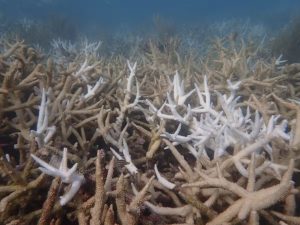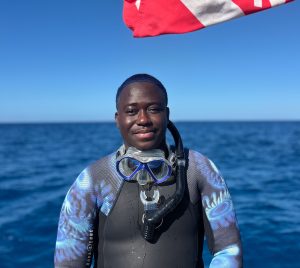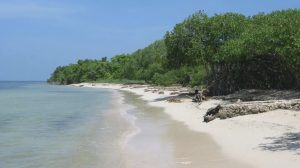It’s World Environment Day, and we couldn’t be more thrilled to announce our mangrove restoration plan for Little Bahama Bank!
Scientists suspect mangroves suffered catastrophic damage when the Category 5 Hurricane Dorian struck Abaco in 2019, and then lingered for days over Grand Bahama. But no one knows the full extent of the damage yet. That’s where PIMS come in.
Empowered by a new grant from The Bahamas Protected Area Fund, we plan to uncover the full extent of Hurricane Dorian’s damage on mangrove ecosystems around Abaco and Grand Bahama using advanced habitat mapping technology, like drones and hyperspectral imaging.
Then, we’ll strategically restore damaged areas that are best-positioned to make a comeback.
“Mangrove restoration is important, but it’s too expensive and difficult to do it everywhere,” said Dr. Craig Dahlgren, PIMS Executive Director. “Using a special-equipped drone, we can look at everything, and then prioritize sites for restoration where we can make the greatest impact.”
.jpg)
Our team plans to photograph thousands of acres of mangroves by air, and then use cutting-edge photogrammetry tools to stitch the photographs together and create high-resolution 3D habitat maps.
“For the first time, we’re able to survey huge areas in just a few hours,” said Will Greene, PIMS Research Associate and drone pilot. “From the 3D models, we’ll be able to measure individual trees that were killed by the hurricane and identify them down to the species level – all from a computer screen.”
Using in-water surveys, we’ll also examine how Hurricane Dorian affected fish and benthic life within mangrove creeks. After we prioritize areas for restoration, we’ll mobilize local community groups and students to help: 1) clean up and remove debris from target mangrove sites, 2) plant and repopulate mangroves in battered areas, and 3) map and track restoration success over time.

Why should we restore mangroves?
So much more than swampy wastelands, coastal mangrove forests are among the most productive ecosystems on earth and provide invaluable services.
Mangroves are climate warriors and sequester massive amounts of carbon annually. Their propagating root networks also provide nursery habitat for thousands of coral reef fish (including key fishery species, like juvenile groupers and snappers), mollusks and crustaceans. In fact, one square kilometre of mangrove habitat is worth up to USD $1.25 million in The Bahamas alone.
Perhaps what distinguishes mangroves the most, however, is their role in protecting our coastline and people from intense tropical storms. At the interface between land and sea, dense mangrove thickets create an important barrier between relentless waves and coastal homes and infrastructure. Without mangroves, a new study reports global flood damages could increase by more than $65 billion annually.
“In the era of climate change and worsening tropical storms, mangroves are our last line of coastal defense,” said Dr. Dahlgren. “That’s why it’s so important that we protect them – just like they protect us – and restore areas that were heavily damaged before it’s too late.”

A project of the Bahamas Protected Areas Fund and the Caribbean Biodiversity Fund, financed by the German Federal Ministry for Economic Cooperation and Development through KfW.

“Seafood Nation” Documentary Premiere Explores the Heart of Bahamian Culture and the Future of Fisheries
NASSAU, The Bahamas | December 5, 2025 – From the bustling stalls of Potter’s Cay to family kitchen tables across the archipelago, seafood is far more than just sustenance in

PIMS and Disney Conservation Fund Partner to Train 19 Government Divers
PIMS dive training in Nassau strengthened national coral restoration capacity across government agencies. Bahamas Dive Training Builds National Coral Restoration Capacity Last fall, between the months of September and October,

Florida’s Coral Reef Crossed a Line: What Functional Extinction Really Means for Elkhorn and Staghorn Corals
Reefs didn’t just bleach. They functionally vanished in one summer. A new Science study co-authored by researchers from the Perry Institute for Marine Science (PIMS) has found that Florida’s two

Q&A: Understanding the IDC Course at PIMS with Duran Mitchell
A former aquarist turned coral conservationist, Duran is passionate about understanding how all marine life connects. PIMS & IDC: Empowering New Dive Instructors for Marine Conservation PIMS & IDC: Empowering

Forbes Shines a Spotlight on Coral Reef Restoration in the Caribbean
When Forbes highlights coral reef restoration, it signals something powerful: the world is paying attention to the urgent fight to protect reefs. And solutions are within reach. Recently, Forbes featured Dr. Valeria

New Reef Rescue Diver Course: Volunteer in Coral Reef Restoration Abroad
Coral reefs are often called the rainforests of the sea—complex ecosystems that shelter a quarter of all marine life, feed millions of people, protect coastlines from storms, and attract travelers



